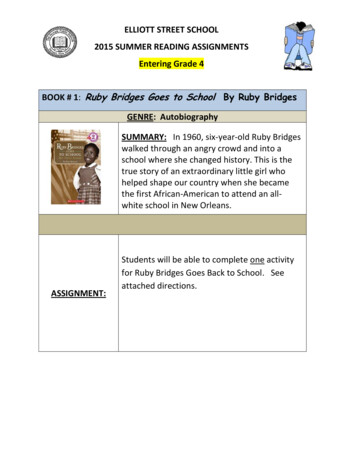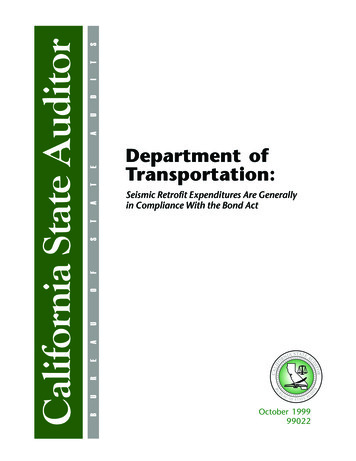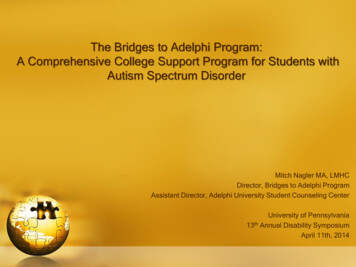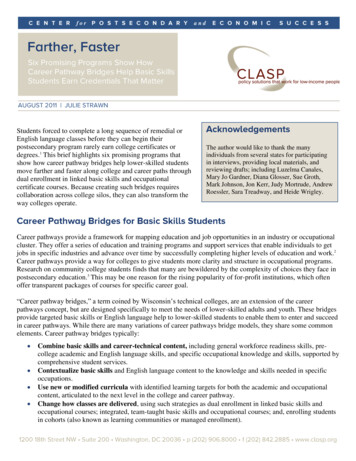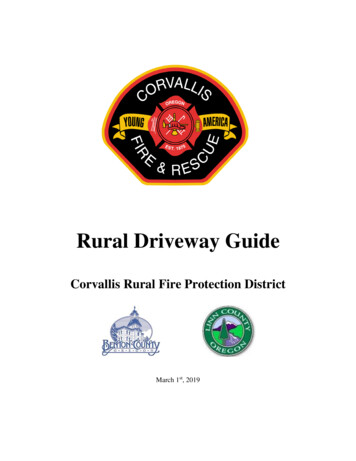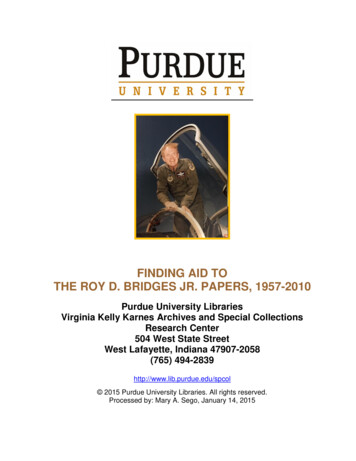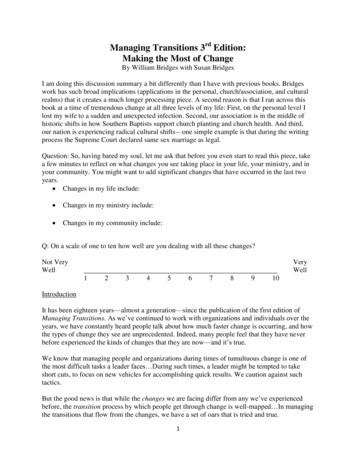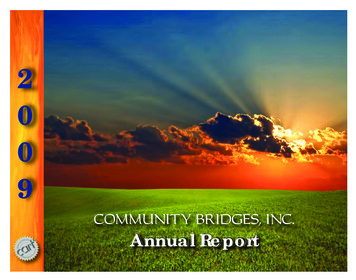
Transcription
Annual Report 2009-final:Layout 112/9/20095:08 PMPage 12009COMMUNITY BRIDGES, INC.Annual Report
Annual Report 2009-final:Layout 112/9/20095:14 PMPage 2Community Bridges is dedicated to providing communitybuilding services to the mainstream public through oureducation efforts and quality treatment for substance usedisorders for men and women. We believe addictionis a disease that carries tremendous consequences forindividuals, families, the workplace, and the community asa whole. Prevention and treatment are the keys tocombating substance abuse.Where We ServeOur Missionand ValuesThe mission of Community Bridgesis to provide the highest qualityClinical Treatment, Family Preservation,Prevention, and Education servicesto reduce the negative impactof alcoholism and drug addiction.We Value Human LifeThe Sustaining of Human LifeAnd the Recovery of Human Life Always with Dignity.2
Annual Report 2009-final:Layout 112/9/20095:14 PMPage 3A Message from the President/CEOA few words come to mind as we reflect on this past yearat Community Bridges, Inc. (CBI): opportunity, challengeand change. All three have helped us to grow, and yetremain true to our mission despite the economic impactbattering our behavioral health system.The Prevention Department delivered valuable servicesto over 20,000 students, their families, teachers, schooladministrators, and support personnel this year alone.Community Bridges continues to provide a wide varietyof services with dignity and respect thanks to the manydedicated men and women who represent thisorganization. Today, Community Bridges employs over300 individuals in programs providing services at 16locations across Maricopa, Gila, Pinal and NavajoCounties.The Center for Hope continues to be recognized as anational model “best practice” long-term residentialtreatment program dedicated to changing the lives ofpregnant women and saving the lives of their babies. The20,000 square feet of living and learning space is hometo 24 women and 32 children. As I write this letter, amilestone is fast approaching as we anticipate the birthof our 100th healthy baby at the Center for Hope later in2009.In 2009, our services have reached farther than everbefore. Our clinicians provided emergency Crisis Careservices to 19,207 men and women, while a total of 3,845adults received lifesaving Medical Detoxificationtreatment services.All of these clinical and prevention/education programsare supported by an army of administrative sitemanagers, maintenance, housekeeping, landscaping,and transportation specialists who keep our programs ontarget 24 hours a day, seven days a week.Our Outpatient programs also saw tremendous changethis past year with the creation of our newest OutpatientServices Center, Journey—A New Beginning, located inGilbert. This new 7,000 square foot facility provides cooccurring disorder treatment, outpatient opiate medicaldetoxification and model treatment programs for youngadults. In 2009, more than 600 men and women receivedtens of thousands of hours of individual and group therapythroughout the State.I am personally very proud of each of our employees.Twice each year (Summer Picnic and Holiday Luncheon)we, as an extended family take a day to recognize theirimpact and say “thanks”. Thanks for your sacrifices, yourblood, sweat and tears, your early morning arrivals, andyour late night missed dinners. I have a personalcommitment to say “thanks” and “keep doing good stuff”to every employee I meet every day. Whether they aresaving lives in Detox or clearing away fallen trees after astorm, THEY are Community Bridges. And I’m grateful theyare.New to Community Bridges this year was the design,construction, and launch of four Rural StabilizationRecovery Units (SRU’s) in Payson, Globe, Winslow, andHolbrook. These new programs provide crisis stabilization,triage, social detox, outreach, and transitionmanagement. Heavily supported by our Peer Supportstaff, they have already served over 1,500 men andwomen.Dr. Frank ScarpatiPresident/CEO3
Annual Report 2009-final:Layout 112/9/20095:15 PMPage 4Our Board of DirectorsEXECUTIVE COMMITTEEPresidentDavid Shumway, PsychotherapistMesa Counseling CenterVice PresidentMichael Whalen, OwnerCenturion SecuritySecretaryJohn Meza, Asst. ChiefMesa Police DepartmentTreasurerBrandon Harrington, VPCohen FinancialLeft to right: Brandon Harrington, David Shumway,John Meza, Michael Whalen.BOARD MEMBERSKyle Jones, Vice Mayor City of MesaKathleen Kelly, Retired City of MesaKevin Kotsur, Chief Avondale Police Dept.Kirsten Lundell, Vice President Brock Supply Co.Bill Mast Community VolunteerPatricia Miller, MSW Retired Social WorkerKerry Ramella, Community Assistance Mgr. Phoenix Fire Dept.Larry Rodriguez, Chief Tolleson Police Dept.Jeri Williams, Assistant Chief Phoenix Police Dept.ADVISORY BOARDFront row, left to right: John Meza,Patricia Miller, Kerry Ramella.Back row, left to right: Kevin Kotsur, Larry Rodriguez,Brandon Harrington, David Shumway, Michael Whalen,Bill Mast, Jeri Williams, Kyle Jones.Not pictured: Kathleen Kelly, Kirsten Lundell.4Honorable Fulton Brock Maricopa County SupervisorGreg T. Fowler, Chief of Police Northern Arizona UniversityHonorable Tom Freestone, Retired Arizona State SenatorHonorable Karen Johnson, Retired Arizona State SenatorHonorable Michael Johnson Phoenix City CouncilmanHonorable John Ore Justice of the PeaceHonorable Don Stapley Maricopa County Supervisor
Annual Report 2009-final:Layout 112/9/20095:16 PMPage 5Major Outcomes & Achievements Received a new three-year certificate of national accreditationfor all of our clinical programs (including our seven newprograms) through 2012 from the Commission on Accreditationof Rehabilitation Facilities (CARF). All of our programs are now certified as integrated alcohol andother drug/mental health (AOD/MH) programs. Expansion of services beyond Maricopa County: Opened fourlicensed Rural Stabilization and Recovery Units (SRU’s) in Payson,Globe, Winslow and Holbrook, AZ. Relocated and expanded outpatient programs in the EastValley to Gilbert, now called Journey-A New Beginning. Implemented the first co-occurring enhanced, medicallymonitored buprenorphine outpatient treatment model in thestate of Arizona. Provided more than 140 community education seminars andprofessional trainings to over 6,000 individuals. Maintained a nationally recognized Peer Support programfunded by SAMHSA in 2009 that provided services to 1,992 menand women. Selected to be the sole provider of Drug Court and pre-trialservices for Maricopa County. Delivered culturally enhanced services utilizing the White Bison“Wellbriety Model” in collaboration with the Navajo Nation andHopi Tribes specifically for individuals entering into care at ourLevel IV facilities in Winslow and Holbrook, Arizona. The Center for Hope opened a new outpatient location inMesa. This location offers on-site child care to womenparticipating in our Continuing Care Outpatient Program. Secured new CDBG funds to develop a housing program forCenter for Hope graduates. Successfully launched the Mesa Prevention Alliance. In the firstyear, over 50 community volunteers became active memberscommitted to developing environmental strategies to combatthe negative effects of substance abuse in Mesa.Stepping Stones in 20095
Annual Report 2009-final:Layout 112/9/20095:17 PMPage 6The Center for HopeSince opening its doors inJanuary 2005, over 90 infantshave been born to womenresiding at the Center forHope. All 90 newborns havehad a negative toxicologyscreen at birth. As weapproach our 5 yearanniversary, we areexpecting our 100th baby tobe born by the end of 2009.Residential TreatmentThe Center for Hope (CFH) program is a unique and nationally recognized best practiceresidential treatment program, providing gender specific services to pregnant and parentingwomen. Services offered at the Center for Hope are provided within a 20,000 square foot campusdesigned to provide a safe, supportive and structured environment while the residents developthe skills they will need to sustain long-term success, mental and physical health, and familystability. Numbers Served — In 2008, the Center for Hope provided state-of-the-art gender specifictreatment services to a total of 88 women. Fifty-four of those women received services in ourresidential program, the remaining 34 women participated in weekly outpatient services as apart of their continuum of care. Children — 24 babies were born to women residing at the Center for Hope in 2008. Thirteentoddlers, age 4 or under, resided at the Center for Hope with their mothers and participatedin our on-site Child Development Center programs, designed to address their developmentalneeds.Continuing Care ProgramThe Center for Hope’s Continuing Care program is designed to meet the ongoing needs ofwomen who have graduated from our residential community. As part of their continuum of care,this program provides gender specific group and individual counseling, on-site child care,transportation, in-home visits, peer support, and intensive case management services to womenand children who have transitioned into permanent housing.
Annual Report 2009-final:Layout 112/9/20095:20 PMPage 7Center for HopeProgram OutcomesThe Center for Hope is committed to improving outcomes. In 2008-2009we experienced significant gains in the following areas:Increased Program Retention and Longevity Women entering the CFH program are staying engaged inservices for a longer period of time and are completing theprogram successfully. 78% of the total discharges in 2008 were the result of meetingtheir treatment plan goals and objectives. In 2008, 68% of the women receiving services at the Center forHope had been in treatment 7 months or more.Housing 95% of the women completing the program in 2008-2009 went into permanent supportive housingat the time of discharge. The Center for Hope provided housing assistance to more than 21 families in 2008-2009.Employment 78% of the women who completed the program in 2008-2009 were employed full-time withincome at time of discharge. 18% of the successful completions were enrolled in school or vocational programs and theremaining 4% were receiving disability benefits.Education Eight women in the program in 2008-2009 completed and received their GED.We believe all womenand children havevalue and worth.We save generationsone life at a timewith unique programsdesigned to empowerwomen, help themovercome barriersand restore their hopefor a new life.
Annual Report 2009-final:Layout 112/9/20095:22 PMPage 8“Healthy communities refersto an environment wherepeople come togetherto make their communitybetter for themselves, theirfamily, their friends, theirneighbors, and others.It fosters an environmentthat creates ongoingdialogue, generatesleadership opportunitiesfor all, embraces diversity,connects people andresources, fosters a senseof community, and shapesits future.”Center for Substance AbusePrevention (CSAP), 2009PreventionPartnershipOur impact in 2008-2009Over 20,449 (11,283 youth and 9,166 adults)individuals were served by the PreventionPartnership over the past year.Between July 2008 and June 2009, thePrevention Partnership provided over 140educational workshops for parents, teachers,law enforcement, the faith community and thecommunity at large. Our dynamic presentationselevate awareness of local substance abusetrends among youth and young adults, provideeducation on signs and symptoms of abuse andoffer immediate resource information.Our Commitment for a Healthy CommunityThe Mesa Prevention Alliance is a community-based coalition that was established in July 2008 by the Community Bridges Prevention Partnership.As we celebrate the undertakings of this first year, the Alliance is now focused on:Addressing youth substance use through education, prevention and healthy alternatives.In one year, the Mesa Prevention Alliance began conducting a comprehensive community needs assessment facilitating 13 focus groups, ninecommunity forums, and concentrated 4,633 staff hours on interviewing, researching and collaborating in Mesa to create a strong prevention planfor the city’s youth and families.With over 50 registered coalition members representing 13 community sectors*, the coalition will focus on two overarching goals in the upcoming2009-2010 fiscal year:1. Increase and strengthen collaboration among community groups and organizations.2. Increase awareness of youth substance use in Mesa.*Schools Hospitals Media Private Health Organizations Businesses / Financial Institutions Community Colleges / Universities Residents Primary Care Faith Community City / Tribal Government Law Enforcement Nonprofits Local Civic / Ethnic / Neighborhood Groups
Annual Report 2009-final:Layout 112/9/20095:22 PMPage 9Crisis Stabilization and Medical DetoxificationCrisis Stabilization services at East Valley Addiction Recovery Center (EVARC) and Central City Addiction Recovery Center (CCARC) provideemergency crisis intervention. Our program offers medically monitored stabilization, triage, evaluation, assessment, and transitional services toindividuals who are experiencing a substance or co-morbid related crisis (acute withdrawal, seizures, DT’s, convulsions, drug-induced psychosis,overdose, etc.).This service provides relief for hospital emergency rooms and emergencypsychiatric centers when an individual’s primary issue is related tosubstance abuse.CRISIS STABILIZATION2008-2009All patients receive a brief assessment based on the American Society ofAddiction Medicine (ASAM) criteria to ensure that patients areimmediately transitioned to the most appropriate level of care.MEDICAL DETOXIFICATION2008-2009Arizona Bridge toRecovery (ABR)Central City Addiction RecoveryCenter (CCARC)East Valley Addiction RecoveryCenter (EVARC)Number of IndividualsServed in Medical Detoxification 3,845 Admissions 15,640 Bed Days 82.9% Average Completion RateNumbers ofIndividuals Servedin Crisis Stabilization 19,207 Admissions 199,578 Hours of CareProvided 87% AverageCompletion RateOur inpatient medical detoxification centers utilize a physician-directed protocol (generally3-5 days) designed to prevent the loss of life that can occur when individuals attempt towithdraw from alcohol or drugs.Community Bridges physicians use medical procedures and protocols nationally recognizedas “Best Practice” approaches for medical detoxification. These medical protocols aredirected by licensed medical practitioners and supported by our clinical team of RegisteredNurses (RN’s), behavioral health technicians, peer support specialists and transitioncoordinators.Our RN’s and transition coordinators work closely with the medical practitioner and otherprofessional and social supports in developing a comprehensive discharge plan that will takeinto account all of the dimensions of the American Society of Addiction Medicine.We continually monitor admission rates, bed utilization, access to care timelines, recidivismrates, and the general demographic make-up of our patients to ensure that the mostefficient and clinically appropriate care is provided.9
Annual Report 2009-final:Layout 112/9/20095:23 PMPage 10Peer Support ServicesPeer Support Outreach Teams are focused on engaging individuals in the community beforeand/or after they have been to any of our clinical programs. Community Bridges has built strongrelationships and an ongoing presence with local law enforcement and other community groupsto engage homeless individuals who are in crisis or living on the streets.Community Bridges now has a team of over 50 Peer Support specialists who can assist anindividual by bringing someone to a 12-step meeting, taking them to their outpatient group,following up with them at their home to “check-in”, or bringing them to one of our facilities.Blueprints to LifeBlueprints to Life is a Substance Abuse and Mental Health Services Administration (SAMHSA)funded program that is a unique collaboration between Community Bridges, the Central ArizonaShelter System (CASS) and the Phoenix Police Department. Blueprints to Life is based on the theorythat utilizing peer to peer services will increase the credibility and availability of existing resourceswithin the greater community.Peers serve as community-based outreach specialists supported by the Phoenix Police inidentifying those areas of the city that have traditionally been absent of outreach efforts. Ourpeers then provide supportive services, which can include linkage to behavioral and mentalhealth crisis, medical detoxification, substance abuse treatment, and shelter services. At CASS,Peers serve as Case Management and Vocational Specialists assisting in the development ofcase plans that are unique to the needs of homeless substance abusers.In 2008-2009, the Blueprints to Life team reachedout to 1,992 men and women on the streets.856 individuals entered into group counseling andover 60 enrolled into Intensive Outpatient Services.10A Project Funded ByWhen the world says,“Give up,” Hopewhispers, “Try it onemore time.”—Author Unknown
Annual Report 2009-final:Layout 112/9/20095:23 PMPage 11Rural Stabilization & Recovery Units (SRU’s)Community Bridges now operates four Stabilization andRecovery Units in Gila, Pinal, and Navajo Counties. Theselicensed Level IV facilities provide triage, crisis stabilization, andshort-term recovery services to those in need.In addition to crisis stabilization and recovery support, ourclinical team determines the following individualized needs: Personal Care Services Continuing Care/Coordination of Care Outpatient Services Crisis Stabilization and Medical Detoxification Transition and TransportationA total of 3,588 bed days were providedat all 4 sites from 2008 to 2009.Number of Patients Servedin Rural Level IV Programs Globe299 Holbrook284 Payson475 Winslow493opened November 2008opened April 2009opened August 2008opened April 2009Community Bridges has obtained Behavioral Health Outpatient Clinic licensesfor the Level IV facilities located in Payson and Globe. We have the ability toprovide many of the services that will occur before, during, and after theindividual is in our care. All four facilities currently provide peer support services,community-based outreach, crisis intervention, and counseling services toinclude traditional healing methods at our Winslow and Holbrook locations.Our clinical model in Winslow and Holbrook is based on Native American cultureand beliefs around healing. This clinical model implements the White Bison“Wellbriety Model” and utilizes the Talking Circle to introduce and process the12-Steps, as well as Relapse Prevention Planning. White Bison also offers a“certification” and “train the trainer” program for individuals to becomeRecovery Coaches, enabling them to provide ongoing training andcertification to staff that will be working at the Level IV Loma Puh’ Tah Vifacilities.11
Annual Report 2009-final:Layout 112/9/20095:25 PMPage 12Outpatient Behavioral Health Services Center for Excellence(North Phoenix) Journey — A New Beginning(Gilbert) Day Resource Center (DRC) Steele Commons (Phoenix) Payson SRU Globe SRUCommunity Bridges operates four licensed Behavioral Health Outpatient Clinics located inGilbert, Phoenix, Payson and Globe, Arizona. Each facility is staffed with Licensed BehavioralHealth Professionals, as well as Paraprofessional staff. Our staff has extensive training in crisisintervention techniques, cognitive behavioral therapy models, such as Matrix, MotivationalInterviewing, treatment of co-occurring disorders, and the Community Reinforcement andFamily Treatment (CRAFT) Model. Our programs are all co-occurring enhanced and caneither be utilized as a step down from a higher level of care, such as Medical Detox, or theprimary source of treatment. Our programs utilize nationally recognized best practice modalities as a standard basis forall of our treatment. Our Outpatient teams coordinate an effective continuum of care with existingprofessional services involved in the individual’s life to ensure successful outcomes. Every clinic also has access to our Board Certified Addictionologist and Psychiatricmedical professionals for both consult and referral.New to outpatient in 2008-2009 at the Center for Excellence in Phoenix & Journey in GilbertAmbulatory DetoxificationCommunity Bridges now offers medically monitored ambulatory detoxification using buprenorphine combined with intensive outpatienttreatment. Adding this level of care has allowed us to meet the community need for opioid medical detoxification services in the least restrictiveenvironment.Our efforts have made an impact by: Decreasing recidivism among 18 to 30 year olds being discharged from inpatient medical detoxification facilities by offering a step down taper(4-7 days). Creating an additional triage capability for our Level I Sub-Acute crisis stabilization facilities while increasing capacity to meet public need. Offering an additional “front door” for the community and providers seeking these highly specialized services. Implementing the first co-occurring enhanced, medically monitored buprenorphine outpatient medical detoxification program in the State ofArizona.12
tAnnual Report 2009-final:Layout 112/9/20095:27 PMPage 13Clinical Services2008-2009Screening, Assessment, & Triage Our team of clinical assessorsprovides comprehensive screening and assessment to determinethe most appropriate level of care utilizing Motivational Interviewing,as well as the American Society of Addiction Medicine (ASAM)Patient Placement Criteria. Results assist in the co-development of aCrisis Plan, which will identify immediate steps to take in the event ofa relapse or crisis event and an initial treatment plan that will designthe course of treatment. This may be immediate placement into oneof our Outpatient Programs or a referral to another level of care. If itis determined that a co-occurring or medical condition exists, theClinical Assessor will coordinate the appropriate level of care.Substance Abuse/Mental Health Outpatient This level of service isdesigned for the individual who requires a lower intensity orspecialized treatment based upon their assessment, as well as theircurrent level of risk according to the ASAM Patient PlacementCriteria. Outpatient Services may consist of individual sessions, familysessions, or group counseling (6 hours or less). Medication servicesare available, in addition to primary counseling, as well as individualappointments with our Addictionologists and/or Psychiatrists.Intensive Outpatient Programs (IOP) Utilizing cognitive behavioralmodalities, IOP offers a minimum of 9 to 12 hours of treatment perweek in the form of group, individual, and family treatment. All of ourIOP models are co-occurring capable and focus on the core areasof addiction, relapse prevention planning, and recovery planning.Random urinalysis is used therapeutically throughout the course oftreatment and patients are continually assessed on their level offunctioning (anxiety, substance use, relapse potential, depression,etc.).“Believe more deeply. Hold your face up to the light,even though for the moment you do not see.”—Bill Wilson, Alcoholics Anonymous Co-FounderMethamphetamine Specific Treatment Community Bridges offersan interdisciplinary treatment model developed by the Los Angelesbased Matrix Institute. Participation in the program is considered tobe part of our IOP model. Each individual is assigned a Peer SupportSpecialist who are themselves in recovery and available to assist inbuilding the bridge from addiction to recovery. The Center forExcellence also utilizes the “best practice” approach ofContingency Management to provide positive rewards for positiveactions and for negative results in urinalysis drug screens. Wecontinue to host the Center for Applied Behavioral Health Policy(CABHP) of Arizona State University to monitor program efficacy andoutcomes.Young Adult (18-30) Opioid Specific Treatment This treatmentapproach focuses on engaging young men and women who areeither coming out of an inpatient detoxification facility or in lieu ofinpatient treatment. A special focus is paid to engaging family asactive participants in treatment.13
Annual Report 2009-final:Layout 112/9/20095:32 PMPage 14Our Generous SupportersWe change lives with your help.Our new playhousedonated by The Home DepotThankYou!Boeing EmployeesJones, Skelton & HochuliChase EmployeesMesa Police Alumni AssociationCity of ChandlerMr. Leonard TorresCity of MesaMs. Judy TapscottCity of ScottsdaleMs. Kathleen KellyCity of TempeMs. Kirsten LundellDeFalco Family FoundationMs. Michelle ArguedasDewaree TrustSAMHSADiscount Tire CorporationThe Home DepotFreeport McMoRan FoundationValley of the Sun United WayGreat American TitleVeryl Law Firm*Contributions from July 1, 2008 to June 30, 2009.Contracts held with the followingRegional Behavioral Health Authorities (RBHA’s)Magellan Health ServicesCenpatico Behavioral HealthNorthern Arizona Regional Behavioral Health Services (NARBHA)Community Partnership of Southern Arizona (CPSA)14
Annual Report 2009-final:Layout 112/10/20097:08 AMPage 15Our Financial ReportREVENUEFederal Grants4%Valley of the SunUnited Way.5%Community Bridgesis a private nonprofitorganization whose solemission is to provide thehighest quality care toour consumers and thecommunity. All of ourprograms are dedicatedto providing the highestprevention andtreatment impact.Prevention Grants,Cities & Other4.5%Regional BehavioralHealth Authorities (RBHA’s)82%Fee for Service9%Administration8%Operating Costs23%EXPENSESDuring 2008-2009,Community Bridgeshad over 300 employeesserving more than45,000 individuals.Community Bridgesruns an effectiveadministrative operationat or below 8% of itstotal operating budget.Direct Costs,Salaries &Expenses (ERE)68%15
Annual Report 2009-final:Layout 112/9/2009OUTPATIENT PROGRAMSJourney1550 North Stonehenge Drive,Suite 104-108Gilbert, Arizona 85233480.962.7922Center for Excellence8825 North 23rd Avenue, Suite 100Phoenix, Arizona 85021602.861.2255Day Resource Center (DRC)1125 West Jackson StreetPhoenix, Arizona 85007602.393.9930Steele Commons1735 Northwest Grand AvenuePhoenix, Arizona 85007602.258.3876WOMEN’S & CHILDREN’SPROGRAMSCenter for HopeResidential Treatment554 South BellviewMesa, Arizona 85204480.461.1711Center for HopeContinuing Care Program1811 South Alma School Road,Suite 285Mesa, Arizona 85210480.831.75665:34 PMPage 16Magellan of Arizona thanks you forVisit us onlineyour continued support for high-qualitywww.CommunityBridgesAZ.orgArizona Bridge to Recovery (ABR)554 South Bellviewrecovery outcomes delivered where peopleMesa, Arizona 85204866.910.1141 or 480.649.1141live, work and play.East Valley Addiction RecoveryCenter (EVARC)Warmest thoughts and best wishes560 South BellviewMesa, Arizona 85204for a wonderful holiday season!480.962.7711CRISIS STABILIZATION& MEDICAL DETOXIFICATIONCentral City Addiction RecoveryCenter (CCARC)2770 East Van BurenPhoenix, Arizona 85008602.273.9999STABILIZATION & RECOVERYUNITS (SRU’s)803 West Main StreetPayson, Arizona 85541928.468.0022105 North Cottonwood AvenueWinslow, Arizona 86047928.289.31515734 East Hope LaneGlobe, Arizona 85501928.425.2415NARBHANorthern Arizona Regional Behavioral Health Authority993 Hermosa DriveHolbrook, Arizona 86025928.524.1151ADMINISTRATION OFFICEAND PREVENTION PROGRAMS1811 South Alma School Road,Suite 160Mesa, Arizona 85210480.831.7566Printed on Recycled Paper with Soy inks.
Community Bridges is dedicated to providing community . social detox, outreach, and transition management. Heavily supported by our Peer Support . Our Commitment for a Healthy Community The Mesa Prevention Alliance is a community-based coalition that was established in July 2008 by the Community Bridges Prevention Partnership.

